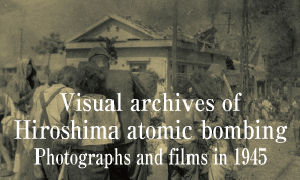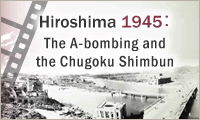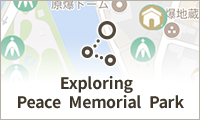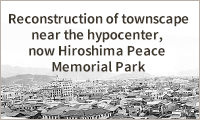Documenting Hiroshima of 1945: Late September, grave markers in Shukkeien Garden
Sep. 30, 2024
by Kyosuke Mizukawa, Senior Staff Writer
In late September 1945, victims of the atomic bombing were being buried in a corner of Sentei Garden (present-day Shukkeien Garden, Naka Ward), into which large numbers of people had rushed shortly after the atomic bombing, at its location in the area of Hiroshima’s Kaminagarekawa-cho. The garden is around 1.4 kilometers to the northeast of the hypocenter. Eiichi Matsumoto, a former staff photographer in the publications department at Asahi Shimbun’s head office, took a photograph of the markers indicating the grave sites.
Originally, Sentei Garden was created as a strolling garden for a daimyo, or feudal lord, with a large pond positioned at its center. In 1620, Asano Nagaakira, the first lord of the former Hiroshima domain’s Asano clan, ordered chief retainer and tea ceremony expert Ueda Soko to design the garden. In 1940, the Asano family donated the space to Hiroshima Prefecture. The garden was designated a national scenic spot that same year.
However, the elegant garden was completely transformed by the atomic bombing. Most of the trees were destroyed and, according to a description in the Record of the Hiroshima A-bomb War Disaster, published in 1971, “Amid the roaring sound of approaching flames, the garden pond was instantly transformed into a bloody swamp for the journey to death.” The Hiroshima Peace Memorial Museum has in its archives an “A-bomb painting” by an A-bomb survivor that shows a scene of fleeing people that had crowded into the area around the pond seeking water.
In Mr. Matsumoto’s photo are grave marker inscriptions, from left to right, reading, “Grave for 5 war dead,” “Grave for 38 war dead,” and “Grave for 21 war dead” — a total of 64 people. In 1987, 42 years after the atomic bombing, the Hiroshima Prefectural Board of Education excavated the site based on evidence in the photos and found several-thousand bone fragments.
The discovered remains were stored in the Atomic Bomb Memorial Mound, located in Peace Memorial Park. A memorial group was later formed of local neighborhood associations and others. In 1988, the group erected a memorial cenotaph in Shukkeien Garden for commemoration of the victims. Since that year, a memorial service for the A-bomb victims has been held every year in the summer. Mr. Matsumoto attended the first memorial service and continued participating until August 2004, prior to his death in December of that same year at the age of 89.
Kikuo Okabe, 75, president of the Kaminobori-cho Kita neighborhood association and vice chair of the memorial group, heard stories from his late grandmother about her experience fleeing to Sentei Garden after the atomic bombing. He said, “Through the memorial cenotaph, I want everyone to understand that many people died here.”
Amidst the chaos of that time, the remains of victims were also buried in such places as Ninoshima Island (in Hiroshima’s present-day Minami Ward), where many of the wounded had been taken.
(Originally published on September 30, 2024)
In late September 1945, victims of the atomic bombing were being buried in a corner of Sentei Garden (present-day Shukkeien Garden, Naka Ward), into which large numbers of people had rushed shortly after the atomic bombing, at its location in the area of Hiroshima’s Kaminagarekawa-cho. The garden is around 1.4 kilometers to the northeast of the hypocenter. Eiichi Matsumoto, a former staff photographer in the publications department at Asahi Shimbun’s head office, took a photograph of the markers indicating the grave sites.
Originally, Sentei Garden was created as a strolling garden for a daimyo, or feudal lord, with a large pond positioned at its center. In 1620, Asano Nagaakira, the first lord of the former Hiroshima domain’s Asano clan, ordered chief retainer and tea ceremony expert Ueda Soko to design the garden. In 1940, the Asano family donated the space to Hiroshima Prefecture. The garden was designated a national scenic spot that same year.
However, the elegant garden was completely transformed by the atomic bombing. Most of the trees were destroyed and, according to a description in the Record of the Hiroshima A-bomb War Disaster, published in 1971, “Amid the roaring sound of approaching flames, the garden pond was instantly transformed into a bloody swamp for the journey to death.” The Hiroshima Peace Memorial Museum has in its archives an “A-bomb painting” by an A-bomb survivor that shows a scene of fleeing people that had crowded into the area around the pond seeking water.
In Mr. Matsumoto’s photo are grave marker inscriptions, from left to right, reading, “Grave for 5 war dead,” “Grave for 38 war dead,” and “Grave for 21 war dead” — a total of 64 people. In 1987, 42 years after the atomic bombing, the Hiroshima Prefectural Board of Education excavated the site based on evidence in the photos and found several-thousand bone fragments.
The discovered remains were stored in the Atomic Bomb Memorial Mound, located in Peace Memorial Park. A memorial group was later formed of local neighborhood associations and others. In 1988, the group erected a memorial cenotaph in Shukkeien Garden for commemoration of the victims. Since that year, a memorial service for the A-bomb victims has been held every year in the summer. Mr. Matsumoto attended the first memorial service and continued participating until August 2004, prior to his death in December of that same year at the age of 89.
Kikuo Okabe, 75, president of the Kaminobori-cho Kita neighborhood association and vice chair of the memorial group, heard stories from his late grandmother about her experience fleeing to Sentei Garden after the atomic bombing. He said, “Through the memorial cenotaph, I want everyone to understand that many people died here.”
Amidst the chaos of that time, the remains of victims were also buried in such places as Ninoshima Island (in Hiroshima’s present-day Minami Ward), where many of the wounded had been taken.
(Originally published on September 30, 2024)






